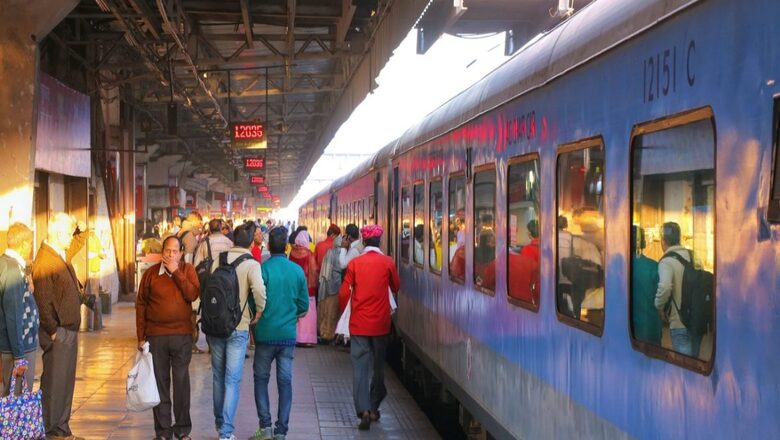
views
I rather begin on a personal note.
In the late sixties and early seventies, whenever I boarded a rickety and creaking coal steam-fired local train from my native Arrah to the oldest, continuously inhabited city in the world — Pataliputra alias Patna — minutes after rolling off the train from the Arrah station platform, on entering Koilwar Sone Bridge, the oldest bridge on Indian Railways (that British constructed hastily after 1857 first war of Independence), the Integral Coach Factory (ICF), Perambur manufactured coaches would start shaking and twisting, moving more horizontally than in forward linear direction. Alarmed passengers would throw change cash coins for the safety of their lives and pray to God.
Decades passed but nothing changed. Even today, the journey over the Koilwar Bridge is a nightmare in local EMUs with electrified traction. The fact that no major accident or casualty has happened testifies to the supernatural protective power of millions of Indian gods and goddesses.
The “Killer Coaches”
In circa 2012, the ‘High-Level Committee on Railway Safety’ headed by noted scientist Dr Anil Kakodkar, based on a special technical analysis by a member of the committee Sanjay Dhande, the then Director of the Indian Institute of Technology, Kanpur and duly strongly advised by Metro Man E. Sreedharan (Advisor to the Committee), dubbed the non-telescoping ICF coaches that went turtle at the drop of hat and recommended immediate cessation of the manufacturing ICF coaches. The committee recommended the Indian Railways (IR) to manufacture only German Linke Hofmann Busch (LHB) coaches.
Nearly a decade went by but mired in cultural status and internecine silo-based fiefdom of IR nothing happened, nothing changed. Killer coaches continued to kill in dozens and not so rarely in hundreds. Even today, more than 35000 ICF coaches are in operation in the IR system.
The History Arrived in Bridal Makeup
Then came 2017, when iconoclast contrarian visionary Sudhanshu Mani, trained as a mechanical engineer at the Indian Institute of Mechanical & Electrical Engineering, Jamalpur. took the helm of ICF as general manager. Under his stewardship, he fathered two ‘Made in India’ state-of-the-art trains nicknamed ‘Train 18’, patented by ICF and created by the same set of staff and officers branded for manufacturing the ‘Killer Coaches’. In 2019, two Train 18 trainsets rechristened ‘Vande Bharat’ were flagged off by Prime Minister Narendra Modi (Delhi-Varanasi) and Union Home Minister Amit Shah (Delhi-Katra) respectively.
The Innovator’s Curse
Sudhanshu on record had told how he had to beg and even offer to touch the feet of the then Chairman of the Railway Board to permit him to manufacture these two trains at much maligned ICF. While India got its Vande Bharat, in a classic tale of “Innovator’s Curse”, the creators of Vande Bharat were hounded by IR vigilance.
The Elephant Awakens and Dances
It was only after Prime Minister Modi embraced Vande Bharat as his own and gave the clarion call from the rampart of Lal Quila when the country was celebrating the historical India@75 moment that “75 Vande Bharat Trains in 75 weeks”, the sleeping Indian elephant thy name is IR, awakened and India showed to the world that “the elephant too can dance.” Even Prime Minister Modi knew that the dream was audacious and impossible, but the truth beckons, in 75 weeks, the country got 25 pairs of Vande Bharat Trains, which translates to 50 trainsets.
Mission Impossible is Possible
The success of the Vande Bharat mission like that of Chandrayaan-3 has emboldened the Indian government to up the ante and dream big for Indian Railways and unlike in the past, work assiduously to achieve them. These are-
- Making 400 Vande Bharat trains operational, including long-distance ones.
- To have only two types of coaches — Vande Bharat and LHB — in the next five years, as against 29 different types of coaches present in IR today.
IR needs to invent its own “next practices”
But to actualise the above two dreams, the IR will need to invent its own “next practices”. The best practices of others often turn into worst practices to follow in the discovery of the unknown. For the uninitiated, I have borrowed the term “next practices” from now classic 2007 last public speech of the late Coimbatore Krishnarao Prahalad (C. K. Prahalad) on his vision of India@75. Prahalad is accredited to be the world’s finest management thinker, next only to Peter F. Drucker, father of modern management.
Time for IR Next Practices Starts Now
It is here that the Union government’s latest reported likely policy shift of Railways, a production-linked incentive (PLI) scheme to boost domestic manufacturing of wheels, brakes, and transmission systems for Linke Hofmann Busch (LHB) and Vande Bharat train sets becomes the first such conceived “next practices”. For a country that is forced to dance to the tune of foreign players for these critical items, this PLI scheme is the nostrum that only works. Apart from giving a boost to first-level and second-level vendors, it will create a culture of innovation and excellence that will take the IR to the next level. Massive local employment generation is the obvious by-product. That award is the only way to up the quality while substantially bringing down the cost.
This will also be IR’s tribute to the true spirit of ‘Make in India’ and ‘Atmanirbhar Bharat.’
Manufacturing State of Art Railway Coaches Not Rocket Science
At present, long-distance high-speed Vande Bharat sleeper coaches are being built in tie-up with foreign OEMs Alstom and a Russian major. I humbly posit the policy needs immediate reversal as making state-of-the-art rail and even metro rail coaches is no rocket science despite the fact that oligopolistic rolling stock and signalling global OEMs, unfortunately, work on the model of manufacture of computer printers, who sell printers costly but make real moolah from selling printer cartridges exorbitantly priced.
If proof is needed of what I say, it is time to look at assiduously developed private vendors of Vande Bharat trains and Indian metro car manufacturers who are manufacturing world-beater aluminium frame (instead of traditional steel metro cars) light and energy-efficient next-generation metro rail coaches. And if the ambition of India to be the manufacturing hub of the world is to be achieved, it has to look east to “how China has done it” and create world-beater rail and metro rail domestic OEMs, be it in the field of rolling stock, signalling or other equipment, and create own home-grown next practices. Otherwise, the ambition of India to export a world-class rail system will die an early death.
But It Is Not Enough
Domestic manufacturing of world-class rolling stock with thriving domestic Level-1 and Level-2 vendors is not enough. Today, Vande Bharat trains with a designed speed of 180 kmph seldom run at 100 km. Railways need to innovate in tracks, weld them through modern welding techniques, invest in bridge modernization, remove permanent and near permanent temporary speed restrictions, straighten curves except where it is impossible and most importantly, create world best practices ‘Make in India’ signalling system. DMRC inspired by Sreedharan’s vision is on the verge of rolling out the ‘Made in India’ state-of-the-art metro rail signalling system. While global rail coach OEMs are an oligopoly, the global rail signalling system OEMs are on the verge of becoming a duopoly. IR signalling system has to be modernized in the India way and its time starts now.
Akhileshwar Sahay, President Advisory Services of rail Consultancy firm Barsyl is a railway expert, Multi-Disciplinary Thought Leader with Action Bias and India-based international Impact Consultant. He was co-opted by Railway Board in 2014 as the only other person on One Man E Sreedharan Committee to transform commercial decision making in Indian Railways. Views expressed in the above piece are personal and solely that of the author. They do not necessarily reflect News18’s views.

















Comments
0 comment